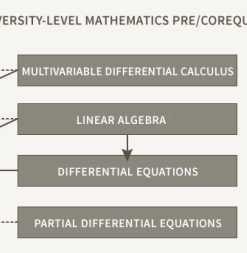Prerequisites
The flowchart below outlines what course(s) students should begin with. In order to enroll in a course, students must satisfy the given prerequisites or the equivalent.
Courses
Light and Heat (XP645)
An introduction to optics and thermodynamics. Topics: temperature, properties of matter, introduction to the kinetic theory of matter, light and electromagnetic waves, reflection and refraction of light, lens systems, interference and diffraction.
Prerequisites: AP Physics C: Electricity and Magnetism, AP Calculus AB, BC, or equivalent.
Required text: Physics; For Scientists and Engineers. P. Tipler, 5th, 6th or Fundamentals of Physics, Halliday, Resnick, 7th or later.
Modern Physics (XP670)
An introduction to the two pillars of modern physics. Special relativity and an introduction to general relativity, experimental basis of quantum theory, quantization of light, Hilbert space structure of qubits, multiparticle states, entangled states, incompatible observables, Bell inequalities, introduction to quantum information and quantum computing, Schrödinger equation.
Prerequisites: Light and Heat and Linear Algebra as corequisite.
Required text: Spacetime Physics, J. Wheeler, E. Taylor, 2nd; Quantum Mechanics, L. Susskind; Six Quantum Pieces, V. Scarani.
Intermediate Mechanics I (XP710)
Intermediate Mechanics covers much of what is generally covered in an upper division university mechanics course. The course is a sophisticated treatment of the mechanics of particles and systems. Tensors, vector calculus, Newtonian laws of mechanics and gravitation, oscillations, Green's functions, calculus of variations, Lagrangian mechanics, orbits, and physics in rotating frames of reference.
Prerequisites: Modern Physics & Differential Equations.
Required text: Classical Dynamics; Of Particles and Systems, S. Thornton, J. Marion, 4th or later.
Intermediate Mechanics II (XP711)
Intermediate Mechanics covers much of what is generally covered in an upper division university mechanics course. The course is a sophisticated treatment of the mechanics of particles and systems. Rigid body dynamics, oscillating systems, Hamilton's principle for continuous systems, waves, general wave equation, and fluid dynamics.
Prerequisites: Intermediate Mechanics I.
Required text: Classical Dynamics; Of Particles and Systems, S. Thornton, J. Marion, 4th or later.
Physics FAQ
XP710/XP711 Intermediate Mechanics
Show
Hide
XP710/XP711 Intermediate Mechanics
The courses were developed directly from the curriculum of Professor Peter Michelson’s courses.
XP645 Light and Heat
Show
Hide
XP645 Light and Heat
Originally developed for EPGY by Professor Mason Yearian in 1995. The thermodynamics portion of the course is now drawn mainly from Professor Douglass Osheroff’s course from about 20 years ago. The optics portion of the course has been revamped to include a more rigorous introduction to electromagnetic waves, polarization, and interference in addition to elements of Professor Osheroff’s course.
XP670 Modern Physics
Show
Hide
XP670 Modern Physics
Originally developed for EPGY by Professor Mason Yearian in 1996 to be comparable to Stanford’s P70 course at the time. This course was redeveloped around 2010 to focus solely on the two pillars of modern physics-relativity and quantum mechanics. This course is distinct from current Stanford offerings (Physics 61 and 71).
Special relativity is approached from a spacetime diagrammatic approach stressing the geometrical structure of spacetime. Building from the principle of special relativity and causality the following are explored: kinematical effects, spacetime metric, Lorentz transformation, relativistic momentum and energy, dynamics. Quantum mechanics focuses on observables with discrete eigenvalues (e.g. polarization) thereby allowing a deeper exploration of Hilbert space, quantum states, operators acting within Hilbert space, entanglement and Bell inequalities, time evolution, uncertainty relations, and solving the Schrödinger equation for simple one-dimensional systems.

